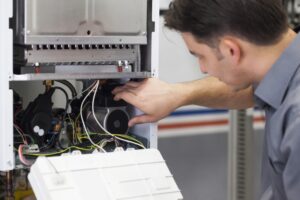We often stress the importance of having furnace maintenance done regularly and explain the ways that it improves the functioning and lengthens the lifetime of your furnace. But perhaps you don’t know exactly what occurs during the maintenance process. Being armed with knowledge about the comfort systems in your own home can be empowering, and we believe that knowledgeable customers are better able to make decisions that they’ll be happy with in the long term.
There are many steps to the furnace maintenance process, and we’d like to give you a behind-the-scenes tour. If you want to know exactly what to expect when you make an appointment for heating maintenance in Ashburn, VA, read on.
Cleaning
The inner workings of your furnace have many parts that will need a thorough cleaning. The flame sensor, pilot assembly, and blower motor are high on this list. For proper functioning, it’s necessary to avoid dust and residue. A thick layer of dust on the flame sensor, for example, may prevent it from detecting a flame. Your furnace, thinking the pilot is out, will refuse to turn on so as not to leak gas.
Checking Components
There are many parts of your furnace that your technician will look at, checking that they are in good condition and functioning the way they should. The ignition system, burner tubes, safety controls, heat exchanger, flue, and ductwork will all be inspected. Your technician will let you know if any repair or replacement of parts is recommended.
Electrical Testing
The thermostat, blower motor capacitors, and every other electrical component and connection are scrutinized and tested. For optimal function and for safety, all connections must be secure, and all components must be properly calibrated.
Lubrication
Your furnace has moving parts, including the blower motor and fans, and moving parts mean friction. Wear and tear and overheating can occur if there is too much friction, so your technician will lubricate all the places where parts move against each other. This keeps everything sliding freely, which helps with efficiency as well as decreasing strain on the system.
Gas Safety
If you have a gas-burning furnace, there are steps that must be taken to maintain safe operation. During maintenance, your technician will check for signs of fuel leakage, inspect the CO detector for proper function, and test for complete combustion of the fuel. If the gas is not combusting completely, carbon monoxide can be created, so this is absolutely critical for your safety.
Filter Change
Although this piece of heater maintenance is something that you should already be doing every 1–3 months, maintenance will include a filter change, too.
Communication
Beyond simply giving you a status update about your furnace’s health, your technician should be clear and open with communication. You should feel comfortable asking your maintenance technician any questions you might have. Don’t worry that a question might feel silly or unimportant. We love to help customers understand their heating systems better. We can also provide tips for maximizing efficiency, extending the life of your furnace, and more.
AllTech Services, Inc. is your trusted resource for heating maintenance and repair. Contact us today!


